

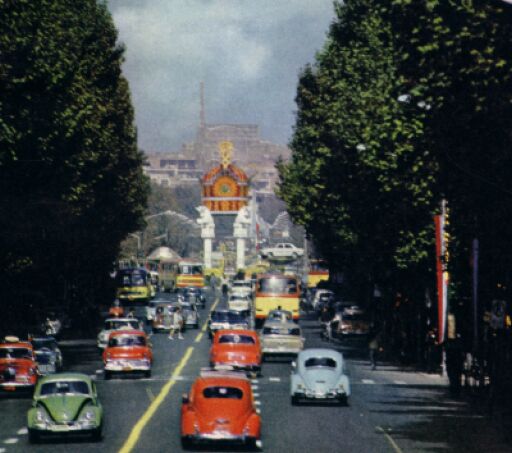
The curiosity was perhaps bigger due to the fact that, marking the new role the Shah wanted to give women in the Iranian society (in the amendment to the Constitution in 1967, it was decided that the Shahbanou would be regent in case of death of the Shah during the minority of the heir to the throne), his wife, Empress Farah, the Shahbanou of Iran, would become the first Empress ever to be crowned in an history of 2500 years. And for that purpose, it was necessary to order a new crown. The honour fell on the famous Parisian jewellers Van Cleef & Arpels, who created the most awesome crown, along with new parures to be worn by the sisters of the Shah at the Coronation.
Also specially ordered for the event was the Coronation Coach, made in Vienna by Josef Klicmann. The carriage was sent by plane to Teheran in peaces and was built there. In blue and gold, it was a replica of the Austrian Imperial Carriage used by the Habsburgs. This was one of the most harshly criticized expenses of the Coronation, because the Imperial had already a carriage, which had been used by the Shah’s father in 1926 and would be used again by the Crown Prince during the procession. The result was, nevertheless, marvellous. A gilded crown, a replica of the Shah’s Crown, topped the carriage and in the door the coat of arms of the Imperial Family was also in gold.

It was decided that the Coronation ceremony would be held in the magnificent Grand Hall of the Golestan Palace, the dramatically stunning former home of the Qajar Dynasty. Also named Grand Throne Room, this magnificent hall was dominated by the Sun Throne, also known as the Peacock Throne, but before it was intended, ever since being built, as a museum room. This remarkably long hall, 150 metres long, was one of those specially refurbished for the occasion. The fact that the Grand Hall could only take around 500 guests, made that in the gardens of the Golestan special tribunes were built to accommodate around 5000 other guests.
In Teheran, the preparations started weeks before the Coronation Day, with models of the Imperial Crown being placed all over the city, especially along the route the cortege would take both before and after the ceremony at the Golestan Palace. The paradisiacal Golestan complex would be the setting of a much expected event and, all around it and in the streets of Teheran, hundreds of thousands of Iranians concentrated before dawn to watch the glamorous ceremony, which began unveiling as the 7500 men from the three services of the Armed Forces took to the streets of Teheran to line the streets. The ceremonial had begun. At 7 am, the 5000 guests that would take place outside the Grand Hall, in the tribunes of the Golestan gardens started to take their places, taken in buses to the Palace so that the traffic wouldn’t spoil the ceremony. The dress code was clear and strict: ceremonial uniform or white tie with decorations for men and long dresses with hats for women. Through the long red carpet in the gardens went by the most awesome long dresses and the most impressive uniforms.
The Imperial Family spent the night in their residence in the Niavaran Palace complex, outside Teheran, and in the early morning, the Shah, the Shahbanou, the Crown Prince and Princess Farahnaz arrived to the Marble Palace, in the centre of Teheran, in helicopter. It was in this same palace that, on the 21st December 1959, the Shah of Iran married the then Miss Farah Diba, who became his third wife but would also later become the mother of the Crown Prince and the Empress of Iran. From that palace she would leave for another unforgettable day in her life, a day in which history would be made, when, like Napoleon I and Josephine, the Shah, the King, the husband, would crown the Shahbanou, the Queen, the wife. The comparisons were numerous, and surely the beauty of the Empress of Iran was as famous as, in her time, the one of Josephine, Empress of the French. No matter how different the ceremony was, no matter how splendorous had been the one of Notre Dame of Paris in December 1804, the Coronation of Teheran would also make history. And this time the press, Iranian and international, was there in force. Television and radio stations, newspapers and magazines, from all over the world, had send special reporters to the expected event. And it was about to start.
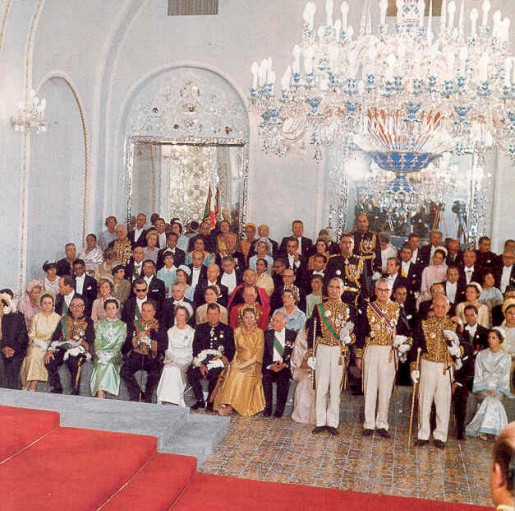
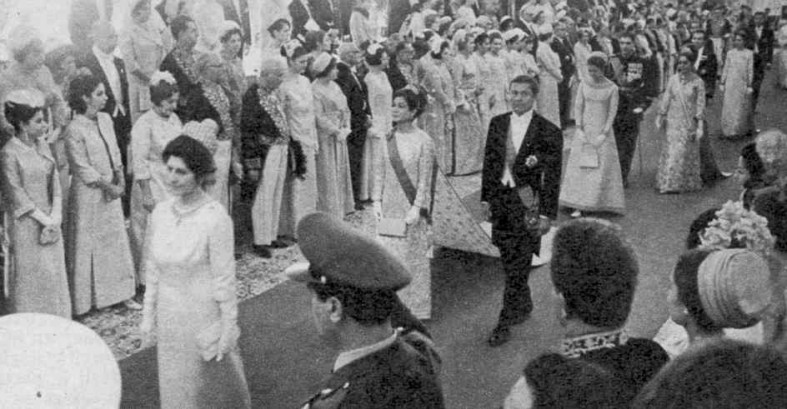
In the Golestan the guests continued to arrive. The most privileged ones, those who would take their places in the sublimely renovated Grand Hall of the Palace, arrived after 9 am. These included the Government of the Empire, members of the Parliament and also the Diplomatic Corps, with a place in evidence for the ambassadors of both the United States of America and the United Kingdom of Great Britain and Northern Ireland. The Ambassadors wore ceremonial uniforms, with gold embroidery, creating a scene that could truly have been taken from the Coronation of Paris, in 1804. The Diplomatic Corps was placed to the right of the throne, when facing it, while to the left were placed the members of the Imperial Family (who entered in procession in the Grand Hall), the most prestigious guests such as the Aga Khan IV (Prince Karim, on whom the Shah had conferred the title of “His Royal Highness” in October 1959), the Begum Aga Khan III (widow of the Aga Khan III, the only woman who attended the Coronation wearing a morning dress instead of the required long one) and Prince Sadruddin Khan (son of the late Aga Khan III), and the Government of the Empire.
In the centre of the scenario, at the end of a long red carpet, was the impressive Naderi Throne, which had been used for the Coronation of 1926 and would be the one in which the Shah would sit during the ceremony. On the left, what would be on the right hand of the Shah and next to the members of the Imperial Family, was the chair for the Shahbanou, with the coat of arms of the Pahlavis embroidered in the back. A similar chair was on right of the throne, next to the Diplomatic Corps, which would be the one for the Crown Prince. The shining, engraved, silver wall behind the Throne provided a glittering backdrop for the Coronation, with the more than twenty magnificent crystal chandeliers hanging from the ceiling of the whole room, over the imposing red carpet, giving the final touch.
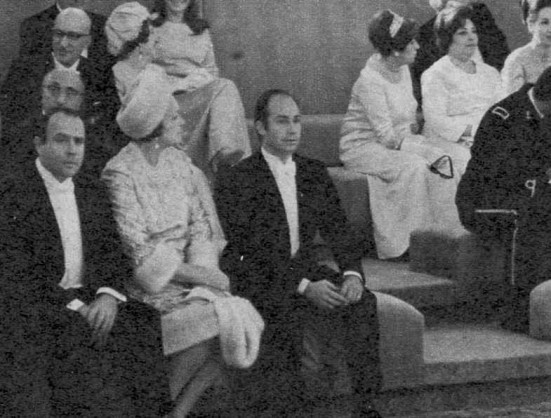
At 10 am, the great ceremonial of the day begun as from the Marble Palace of Teheran emerged Their Imperial Majesties The Shah and The Shahbanou of Iran in the new splendid Coronation carriage, pulled by eight beautiful white horses specially brought from Hungary. All around the carriage the footmen wore very impressive red coats. The cortege included several mounted regiments and bands in remarkably colourful uniforms with red dominating the scene. One hundred metres behind the blue Coronation Carriage came the Crown Prince’s Carriage, in which the small Prince Reza Cyrus travelled accompanied by a senior military. Several minor health scares had brought doubts over his ability to take part in the Coronation ceremony, but at the end he would be the most remarkably noticed. During the cortege and advised by the military who accompanied him, he saluted right and left.
The crowds had taken to the streets in absolutely huge numbers. Some figures put it in 4 million people to watch the corteges. The slow and dazzling procession went through the most important streets of the Iranian capital, undoubtedly marking those who watched the beautiful blue carriage go past, carrying the man who was doing so much for the future of the country, and the woman who had been his support for less than ten years but had given him the necessary strength and support. And in the other carriage, the heir of the Empire, amazed, contemplating as history unfolded in that remarkable day in which so many people cheered him and his parents. His decency and his seriousness amazed many who appointed in him the personification of the perfect heir to the millenary empire.

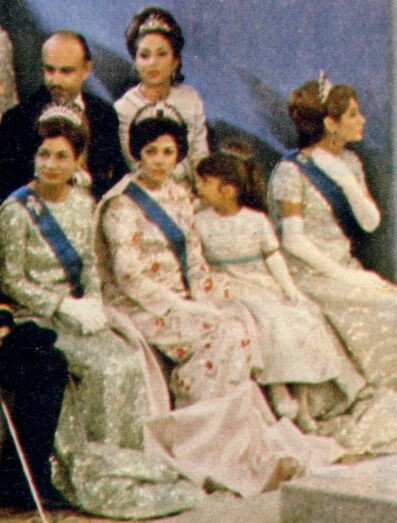
Forty minutes later, the imperial cortege arrived at the Golestan Palace but not through the gardens in which the 5000 guests were sitting. It was through a discreet smaller entrance that the Shah, the Shahbanou and the Crown Prince entered the palace complex, to rest for a few minutes in the blue tent that had been mounted in the gardens. The magnificent ceremony was about to start and nervousness and anxiety could be read in everyone’s faces. For 26 years the Shah had delayed his Coronation and the moment had come. The solemnity was enormous, the silence almost scaring, as the corteges prepared to enter the Grand Hall.